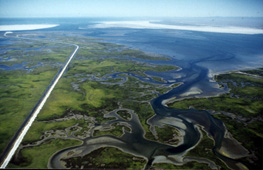Holy Cow! What a Calf
Keith Jones is crazy about the baby whales in the lagoons. This seasoned guide, photographer, and naturalist describes gray whale babies that are born in the warm lagoons in December, January, and February each year:
Cute
Babies!
| Do
you see the baby's dimples? |
|
|
| Gray
Whale Nursery Lagoons |
The births mostly occur from early January to the end of February. The gray whale baby grows inside its mom for is 11 - 13 months. A newborn gray whale is around 15 feet long at birth. It weighs about 2,000 pounds. In some cases, another gray whale (called an "auntie") helps during the birth. The auntie may help hold the mother above the water, so the calf can be born headfirst into the air. If it's born under water, the auntie or the mother will help boost the baby as it swims to the surface for its first breath of air. They watch the baby with care.
Baleen
Instead of Teeth Photo The Orca Network |
The pregnant females and those with calves stay in the inner lagoon, farthest from the sea. The warmer waters of Baja Mexico's shallow lagoons help newborns to conserve body heat. Babies are born lean and relatively blubberless. The calves nurse for around 6 months. The mother provides up to 50 gallons of milk each day. Her milk contains 53% fat. Such rich milk helps calves gain 60 to 70 pounds daily! It helps them build up thick blubber for their cold trip north.
Mom
and Baby: a Great Team. Photo Keith Jones |
Much
to Learn
Mothers stay near their young to protect, teach and guide. Babies
have much to learn. They must also gain strength. They spend
most their time swimming alongside Mom. When they get tired, they
stretch out sideways across Mom's back to rest. Sometimes
the mother extends a fin to support the calf. This is
very
much like an adult parent, who might place a hand under a child's
stomach while teaching the child how to swim. The moms even let their
babies approach the small boats that hold curious tourists who come
to see the whales up close. The whales seem to trust the people.
The whales are gentle, and everyone makes new friends!
Try This! Journaling Question
- What evidence indicates that gray whales are "good" mothers?
- Why do you think the lagoons are good environments for baby whales?
- How much will a baby gray whale weigh if it starts the journey north at about two months of age? (Be careful! Remember how much it already weighs at birth, and how much it gains each day.)
National Science Education Standards
- Plants and animals have life cycles that include being born, developing into adults, reproducing, and eventually dying.
- Environments are the spaces, conditions, and factors that affect an individual's and a population's ability to survive and their quality of life.






